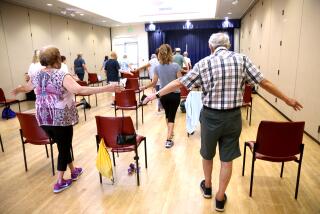The Up-and-Down Charts of Age and Body Functions Under Study
- Share via
WASHINGTON — Stanley N. Gershoff, dean of the Tufts University School of Nutrition, remembers a graph he saw a few years ago that showed the relationship of age to various human functions.
“No matter what you looked at,” he recalled recently, “whether it was hearing, sight, lung capacity, kidney function, heart function, the slope kept going down as age went up. Everything starts going down somewhere in the 20s for as long as you live.”
This, of course, is no surprise to older people, most of whom can attest to this fact without recourse to graphs or charts.
But Gershoff’s point goes further. “Not everything,” he said, “goes down at the same rate, and not everybody has things going down as quickly as everybody else. Our function in nutrition research is to change the slope of those curves (on the graph) so that they don’t go down as steeply.”
One way to do that is to determine whether nutrition plays a role in why one person’s kidneys fail, or another’s hearing goes, while both have strong hearts and good bone mass. That’s an example--there are endless combinations of one or more functions breaking down in no special order that scientists can yet recognize.
Different Requirements
Indeed, researchers have only recently recognized that the nutritional requirements of older people may be significantly different from those of young or middle-aged adults. Complicating this is a growing awareness that among the older population there is a vast diversity of physical characteristics.
“Aging produces an increased heterogeneity in almost all physiologic measurement,” wrote Dr. Edward L. Schneider, deputy director of the National Institute on Aging, in a recent issue of the New England Journal of Medicine.
So it becomes difficult, well nigh impossible, to generalize about what older people might need, in terms of nutrition, medications, exercise or anything else. “The frequent use of the category ’65 and above’ to present a presumably homogeneous group,” Schneider wrote, “is being increasingly recognized as inappropriate.”
“One of the problems,” Gershoff said, “is that . . . when you get to elderly people, they almost invariably have some kind of chronic disease, so one has to look at them somewhat differently.”
Tufts researchers are studying the effects of nutrition on the aging process to help determine the needs of older people.
Beyond the now well-known fact that calcium deficiency built in over a lifetime can affect bone density in the elderly--resulting often in osteoporosis, or fragile, easily fractured bones--there have been few cause-and-effect findings relating nutrition to age-related conditions.
Now, however, at Tufts and a few other centers, in studies backed by the National Institute on Aging and the U.S. Department of Agriculture, research is accelerating in an attempt to meet the needs of the growing numbers of older Americans.
Researchers now have established that continued calcium supplementation in the neighborhood of about twice the current adult recommended dietary allowance (RDA) of 800 milligrams a day is needed by most older people to help forestall osteoporosis. For calcium to be absorbed, however, a form of Vitamin D is required. As people age, the ability to synthesize Vitamin D diminishes, both because of age-related deterioration of kidney function and because of changes in the skin.
Vitamin D--often called the “sunshine” vitamin--can be produced by the skin from sunlight. The skin’s ability to do this decreases significantly between the ages of 50 and 90, Tufts’ physiology professor Dr. Michael Hollick found.
Impact of Variables
Although most nutritional dogma has held that protein requirements diminish once a growing boy or girl is grown, new research is demonstrating an increased need for protein in the elderly. “Since lean body mass declines with age,” wrote Schneider, “this increase in protein requirements apparently reflects age-related changes in protein absorption or metabolism (or both).”
But even these findings can be complicated or changed by variables, including drug use, health conditions, life styles, weather--even the safety of a neighborhood or the way dentures fit.
For instance, an older person with arthritis who takes a great deal of aspirin may have chronic intestinal bleeding and require extra iron, or more of certain B-complex vitamins and perhaps a little additional Vitamin C. Fiber, eaten to help along slowing intestinal action, may deplete the body of other trace minerals or vitamins. Gershoff talks about the older people living alone who are either afraid to go out or blocked by bad weather from shopping who “just sit at home and eat tea and crackers.”
To add to the problem, age typically brings an increased sensitivity to toxicity, so do-it-yourself treatments can be dangerous, even with relatively small amounts of vitamins. Vitamins A, D, E and K are fat-soluble and can build up in the body, so even small daily doses can eventually reach poisonous levels.
Indeed, any vitamin megadose is potentially dangerous, especially in the elderly.
One of the concerns at Tufts, Gershoff said, where about 1,000 older people are about halfway into a four-year nutritional study, is that the elderly are buying into the pretensions of food faddists who claim to be nutritionists but usually are not. Swayed by promises of long life and good feelings, they are not only wasting money, but may be contributing to their own poor health.
In a related area, the current system of Medicare payments, some specialists believe, may even be encouraging malnutrition among the hospitalized elderly. A recent American Dietetic Assn. survey of 800 hospitalized patients disclosed that although 55% of the patients were likely to be malnourished, fewer than 5% received nutrition therapy. Among older patients, 60% were at risk for malnutrition.






